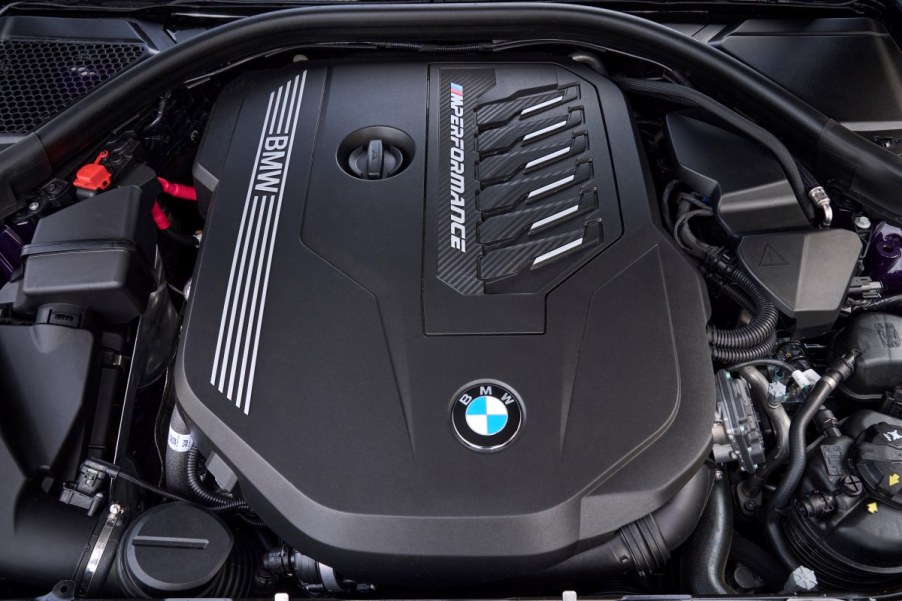
The BMW Twin Scroll Turbo Solves 2 Big Problems with Turbocharged Cars
With the introduction of BMW’s N55 engine, BMW switched from twin-turbo six-cylinder engines to something called TwinPower Turbo. While previous setups used two separate turbos, the newer BMW twin scroll turbo is quite a bit different. Even if you already know how a traditional turbocharger works, the BMW Twin Scroll turbo is a much different animal. Here, we’ll explain both the differences as well as the advantages and disadvantages of this new turbo setup.
How does a turbocharger work?
Whether it’s a standard turbocharger or a BMW Twin Scroll turbo, the concept of a turbocharger is the same. As the engine burns fuel, it expels gases through the exhaust manifold. In a non-turbo car, this gas simply exits the vehicle through the tailpipe.
However, a turbocharged engine puts a turbine at the end of the exhaust manifold before those gases flow to the rest of the exhaust system. This exhaust spins a turbine that then sends pressurized air back into the combustion chamber to improve performance. The added, highly-compressed air improves combustion strength for enhanced power and torque.
The differences between a Twin Scroll turbo and normal turbo

In a standard turbocharged setup, exhaust gases exit through a single exhaust manifold on their way to charge the turbo. The BMW Twin Scroll setup amplifies this principle without the use of a second turbocharger. Instead, the system splits the exhaust gases to provide two streams of air to accelerate the turbo.
A larger channel shoots half the exhaust stream to the outer edge of the turbo blades. Meanwhile, a second, smaller channel directs air toward the center section of the turbo. The larger, outer channel raises the RPM of the turbocharger to provide a bigger boost. Meanwhile, the smaller channel improves turbo response for less turbo lag. The result is a turbocharged engine with both improved low-end response and better power at the top, as BMWBlog explains.
The exhaust manifold holds the key to turbocharging success
No matter which type of turbo it is, the exhaust manifold is critical to improving engine power. The more quickly and efficiently the manifold can channel exhaust gases out of the engine, the better throttle response and overall power are available.
With smaller packaging comes an uneven exhaust manifold design, where each cylinder feeds into channels of differing length. This alters, and ultimately hinders, efficient performance and can even cause disruptions in ignition timing if the system is too restricted.
Twin scroll turbos solve the backpressure problem
Because a turbo adds resistance to the exhaust system, back pressure is a problem with turbocharged cars. However, the BMW twin scroll setup solves this issue while using the uneven exhaust pressures to its advantage.
For one, the separate exhaust tubes prevent back pressure interference by separating the cylinders that are working against each other. This smooths overall exhaust flow, which, by itself, can make for better performance.
Furthemore, the added efficiency of the twin scroll turbo system allows for unique tuning with a higher ignition delay. The result is a slightly lean fuel-air mixture that also improves engine temperatures and overall efficiency.
Are there downsides to a BMW twin scroll turbo?

As with any system, there are trade offs. And despite all of the advantages of the BMW twin scroll turbo, it is no exception. The twin scroll turbo takes more space than a standard single turbo, which can make maintenance and upgrades difficult. In addition, if the turbo needs to be replaced, it is a much more costly component than a single turbo setup.
Are BMW twin scroll turbos better than the old twin turbos?
Better is relative, but overall the twin scroll turbo setup in new BMWs does offer more advantages than disadvantages. It offers similar power from a lighter, more efficient, and more compact package. And while it can be more complex to work on, the added failure points of a true twin turbo system give the twin scroll an edge overall.




